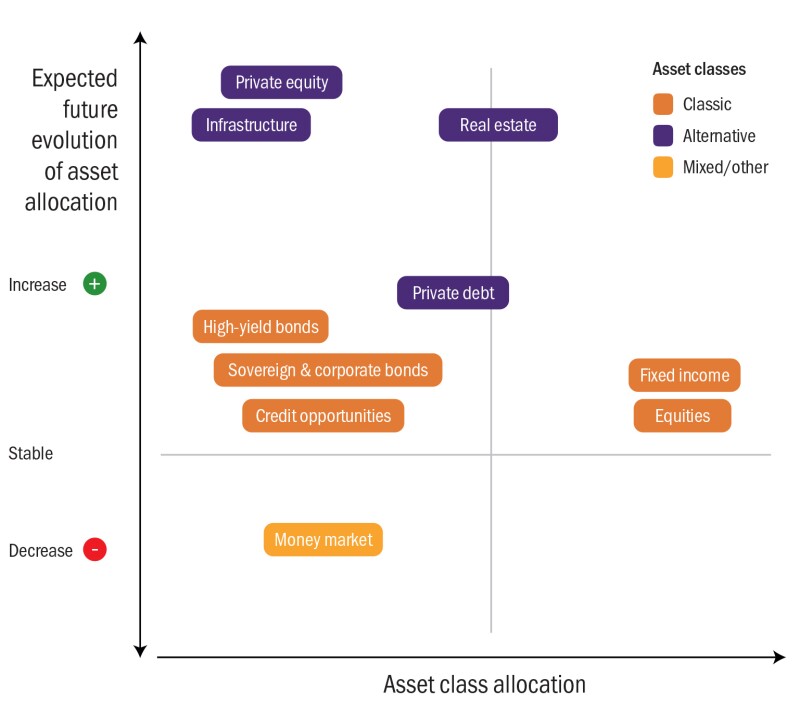Introduction
This article on the asset management industry explores how evolving trends in asset classes managed by asset managers and their value chains could have an impact on transfer pricing models.
As part of a recent survey of asset managers conducted by Deloitte Luxembourg and Deloitte Ireland that looked into which assets asset managers are likely to focus on, fixed income and equities (which are considered to be classic, or traditional, asset classes) remained the most prevalent asset classes in 2021. However, others are on the rise.
The chart in Figure 1, based on the findings of that survey, shows that private equity and infrastructure assets are expected to increase the most, followed by private debt and real estate. All four are considered to be alternative asset classes for these purposes. Those asset managers surveyed expected to keep their allocation in equities and fixed income stable while decreasing their exposure to money market instruments.
Figure 1

Source: EMEA Asset Manager Survey conducted by Deloitte Luxembourg and Deloitte Ireland – survey of 11 asset managers (AMs) with a combined €9.7 trillion ($9.9 trillion) of assets under management (AuM). Headquartered in five countries across Western Europe, the asset managers interviewed were considered to be a representative sample of the industry, covering a range of organisations, including liquid-only or illiquid managers, those belonging to larger financial groups, independent firms, or insurance companies, and those who manage in-house or third-party funds.
In the past, alternative investments were generally considered to be a niche investment; for example, for investments for high net worth individuals. However, an extended period of low yields and returns has led to other investors – for example, institutional investors – also exploring alternative investment channels, in addition to traditional investment channels, for better returns.
In response, alternative investments have become more mainstream, with asset managers that may have typically focused on traditional products expanding their product ranges to offer more bespoke asset classes to appeal to a wider range of investors.
At the same time, there are a number of other external factors affecting the industry and the demand for investment products from a wider range of investors, including:
Demand for funds with environmental, social, and governance (ESG)-focused strategies. The core of the trend may be socially responsible investing, but investment managers are still working on matching ESG priorities with investment return expectations.
Increasing demand for cryptocurrencies and digital assets has given investment management firms an opportunity to create new products by bundling these currencies into funds with different risk and return characteristics (Deloitte Insights – 2022 Investment Management Outlook).
Rising energy prices exacerbating inflation. Inflation can erode the real returns of investments and can also impact the investment strategy of investors, as they look to diversify assets to limit their exposure to inflation and reassess their goals in terms of returns.
TP considerations
For an asset manager looking to move into alternative assets, or extend its alternative asset offering, it will be important to consider what effects this could have on the group’s transfer pricing model. In some cases, this may mean that existing transfer pricing policies can be adapted, whereas in others there may be a need to have separate transfer pricing policies in respect of different asset classes.
As with any transfer pricing analysis, the starting point is a detailed understanding of the facts, and the functional analysis.
The transfer pricing analysis should consider differences between the company’s business model and value chain and any new alternative investment business models and value chains, with some examples noted below.
Alternative asset managers could be more involved in business and market research activities; for example, talking to potential investment project developers and actively performing due diligence and the negotiation of investment terms.
These activities might take place over a number of months, whereas for traditional products the business and market research activities could take place over a shorter timeframe and not require all the stages noted. From a transfer pricing perspective, consideration would need to be given to how this additional activity carried out by the asset manager should be remunerated.
The possible need for additional specialist know-how.
Following an investment decision for alternative assets, internal (product) specialists would typically take over the management of the investment at an asset level given that the nature of these assets is typically more long term and illiquid compared with traditional assets (for example, for real estate asset investment, product specialists could be involved in considering if any enhancements need to be made to an asset). To be close to the investment managers, these product specialists are often part of the investment team.
From a transfer pricing perspective, this specialist know-how needs to be taken into account in determining how this function should be remunerated – a detailed analysis should determine if this activity could be described as an “administrational process step using specialist know-how” or “decision-making activity during the holding phase of the alternative investment”.
Additional business complexity may come from regional diversification of investments; for example, infrastructure investments can be split across countries/regions and require specialist local/regional know-how (such as the political risk of investing in critical infrastructure, which might be re-called by the government at a price different than market).
As with any other business process where teams are specialised in different (sub)sectors or country/regional specific know-how is used, the transfer pricing analysis needs to determine if the transfer pricing methodology for the alternatives business needs to further distinguish between, for example, different infrastructure investment classes (solar parks versus public transportation versus oil/gas pipelines versus highways).
Although traditional asset classes may differ – for example, European equities versus Asia-Pac equities – the underlying investment is substantially the same, whereas for infrastructure the nature of the asset can substantially differ and therefore specialist know-how and each team’s input into the value chain may differ.
Typically, for alternative investments, investment decisions are taken by an investment committee (IC) composed of senior alternative investment managers and other senior management representatives of the company (for example, the chief investment officer and legal counsel).
Where this is the case, the investment manager may present a business case to the IC based on the initial research and preliminary discussions to secure the go-ahead for conducting the due diligence and negotiations. They then generally present the full investment case, including economic simulation, for approval by the IC. Consequently, it has to be determined if the IC should be separately remunerated from a transfer pricing perspective for taking up the decision risk.
Whilst traditional asset classes will also often have an IC, they typically tend to be in place to agree investment strategies for funds/asset classes that the investment managers then execute within certain parameters. This is where the role of the IC between traditional asset classes and alternative asset classes may differ and additional considerations may need to be taken into account.
New legal entity structures.
For example, if crossing over from an unregulated to a regulated environment, as the investor base expands from high net worth individuals, alternatives products can require a different business/administrative set-up, potentially including new legal entity structures in some instances and therefore impacting how the value chain is split, and this needs to be considered across the various jurisdictions.
How will the alternative products be distributed? Will there be new dedicated distribution teams, or will the existing sales structure introduce the alternative products to their existing client base?
The remuneration of distribution activities needs special attention as well. Alternative products are mostly excluded from retail distribution, due to the complexity and length of holding of the product. On the institutional sales side, the client relationship will typically remain with the existing institutional sales teams/representatives as they have already built up relationships with the instructional investors and any changes have to be valued from a transfer pricing perspective.
At the same time, presenting and explaining the products will often be conducted by the investment managers or product specialists. Therefore, a detailed analysis of the respective sales value chain (including roles, responsibilities and contribution to the investment success) should be carried out to determine appropriate transfer pricing remuneration for the distribution/sales teams.
Conclusion
From a transfer pricing perspective, it is important to understand the changed roles and responsibilities of any new business function and value chain. These business changes might require an amendment of the company’s existing transfer pricing functional and risk profile analysis and possibly the transfer pricing methodology itself.














